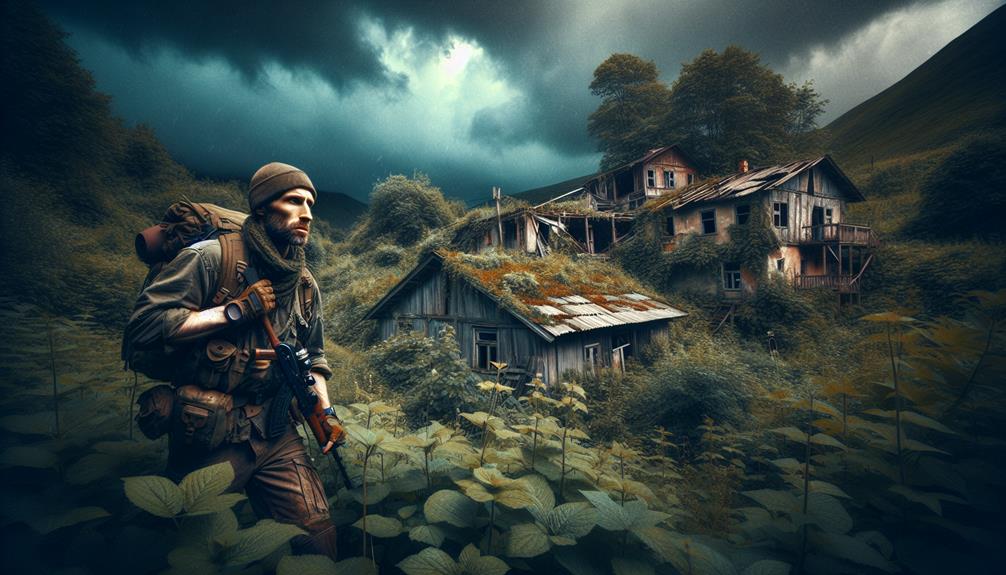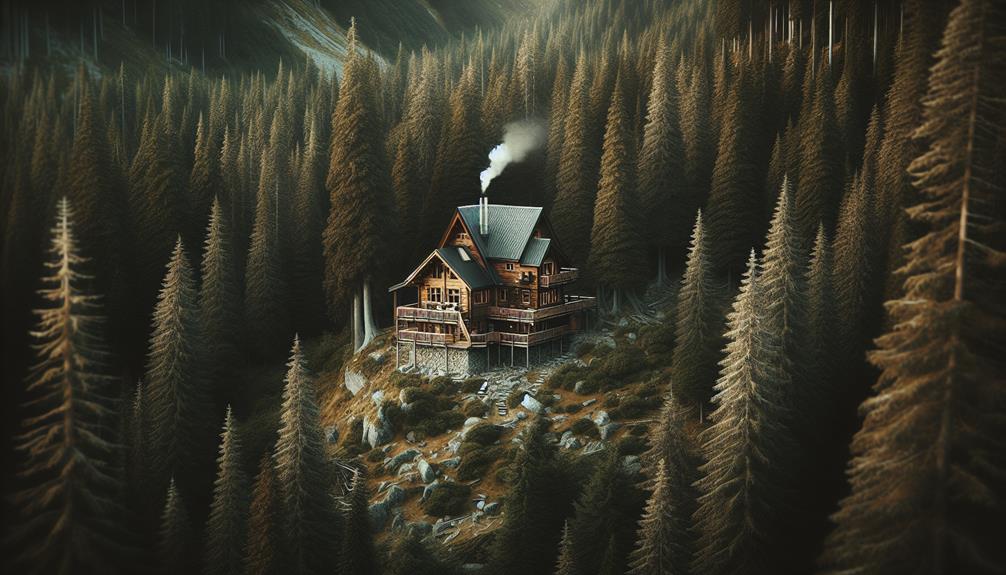Finding remote storm shelter locations for survivalists means we need a strategic and analytical approach. We'll evaluate natural caves and their structural integrity, making sure they're accessible and free of wildlife risks. Examining abandoned structures and constructing underground bunkers can offer safe, secure options with proper ventilation and stockpiled supplies. Remote cabins provide off-grid sustainability with solar panels and water systems. Evaluating geographical features for natural protection and proximity to resources like fresh water and wild edibles is vital. Let's consider these criteria to guarantee long-term safety and self-sufficiency during extreme weather events, offering deeper insights into ideal shelter strategies.
Key Points
- Evaluate natural caves for structural integrity, accessibility, and potential wildlife risks.
- Choose remote cabins equipped with solar panels, water systems, and heating sources for sustainable off-grid living.
- Ensure proximity to fresh water sources and assess availability of wild edibles, game, and firewood.
- Install reliable ventilation and waste management systems in all shelters for a breathable and sanitary environment.
Understanding Shelter Necessities
To fully grasp the importance of shelter in a survival scenario, we must first analyze the essential functions and features that a storm shelter must provide. Our primary concern is protection from extreme weather conditions. Shelters must be sturdy enough to withstand high winds, heavy rain, and flying debris. Without a solid structure, our safety is compromised.
Next, we need to contemplate emergency supplies. A well-stocked shelter should have enough food, water, and medical supplies to sustain us for at least 72 hours. This includes non-perishable food items, water purification tools, first-aid kits, and any necessary medications. Proper storage systems help ensure these supplies remain uncontaminated and accessible.
Ventilation systems are another critical component. Adequate airflow prevents the buildup of harmful gases and maintains a breathable environment. Simple solutions like air vents or more sophisticated systems with filters can be employed, depending on the shelter's design and our specific needs.
Incorporating these elements strategically guarantees that our storm shelter isn't just a temporary refuge but a sustainable environment where we can maintain our health and safety. Understanding these necessities empowers us to prepare effectively and enhances our sense of autonomy and freedom.
Evaluating Natural Caves
When evaluating natural caves for storm shelter purposes, there are several key factors to consider. The first aspect to focus on is the structural integrity of the cave. This involves checking that the cave walls and ceiling are stable and not at risk of collapsing during a storm.
Another important consideration is the accessibility of the cave. It's crucial to assess the entrances and exits to ensure that they allow for easy entry and exit, especially under emergency conditions.
Additionally, it's essential to identify any wildlife or other inhabitants that could pose a risk to your safety while sheltering in the cave. This includes potential threats such as snakes, bats, or other dangerous creatures that may inhabit the cave.
Taking all of these factors into account will help ensure that the natural cave is a safe and reliable storm shelter option.
Structural Integrity Assessment
Evaluating the structural integrity of natural caves requires a meticulous examination of geological formations, potential weaknesses, and stability indicators. First, we need to understand the types of rock formations present. Limestone, for example, is prone to erosion, which could compromise the cave's stability. Granite, on the other hand, often provides a more solid foundation.
Safety precautions are essential; inspecting for signs of recent rockfall or water intrusion can reveal weaknesses that mightn't be immediately apparent.
Next, we should consider the construction methods we might employ to enhance the cave's structural soundness. Reinforcing weak points with steel supports or using concrete to stabilize loose sections can greatly improve safety. It's also vital to assess the need for emergency supplies; stockpiling food, water, and first aid kits can make a significant difference in survival situations.
Ventilation systems are another important factor. Natural caves can harbor pockets of harmful gases or suffer from poor airflow. Strategically placed ventilation shafts or mechanical systems can guarantee a constant supply of fresh air, essential for long-term habitation.
Accessibility and Entrances
Frequently, we must strategically analyze the accessibility and entrances of natural caves to guarantee they can serve as reliable storm shelters. First, we assess the primary entrance to confirm it's both accessible and secure. A well-hidden entrance offers natural camouflage, essential for maintaining our privacy and security. We prioritize caves where the entrance is easy to navigate yet not easily spotted by potential threats.
Next, we evaluate the need for emergency exits. A secondary exit can be a lifesaver if the primary entrance becomes blocked. We scrutinize potential emergency exits for ease of access and structural integrity, confirming they won't compromise our safety.
Ventilation is another crucial factor. Proper airflow prevents the buildup of harmful gases and ensures we don't suffocate. We look for natural caves with multiple openings or natural air shafts, which facilitate ventilation. If natural ventilation is inadequate, we consider ways to enhance airflow without compromising security.
Wildlife and Inhabitants
Understanding the potential dangers posed by wildlife and other inhabitants is essential when selecting a natural cave as a storm shelter. We must assess the risks of wildlife encounters, considering both the species that inhabit the area and their behaviors. For instance, caves often serve as homes for bats, snakes, and larger predators like mountain lions. Identifying signs of recent animal activity, such as tracks, scat, or nesting materials, helps us gauge the frequency of visits and the likelihood of dangerous interactions.
Human interactions also need consideration. A cave that sees regular use by local hunters, hikers, or even other survivalists mightn't offer the seclusion we seek. Local knowledge becomes invaluable here. Engaging with the community can provide insights into which caves are frequently visited by wildlife or humans. Community support can also offer guidance on caves that are best suited for temporary shelters because they're less likely to be disturbed.
Strategically, we should prioritize caves that offer a balance between accessibility and isolation. By doing so, we minimize the risk of unwanted wildlife encounters and human interactions, ensuring our chosen shelter provides the safety and freedom we desire.
Utilizing Abandoned Structures

When we strategically assess abandoned structures for use as storm shelters, we must consider their structural integrity, accessibility, and potential hazards.
Urban exploration offers a unique opportunity to discover these hidden gems, but safety precautions are essential. We need to verify the building's stability, ensuring it can withstand harsh weather. Checking for signs of wear, such as cracks in walls or weakened foundations, is pivotal.
Accessibility is another key factor. We should evaluate the ease of reaching the location, especially under storm conditions. Paths must be clear, and the structure should be reachable without excessive effort. Proximity to our primary living area is also crucial for quick evacuation.
However, legal implications can't be ignored. Abandoned structures, though seemingly free for the taking, are often subject to property rights. Trespassing can lead to legal issues, so identifying the property's legal status is indispensable. We might need to seek permission or even acquire the property.
Lastly, potential hazards within the structure, such as mold, asbestos, or unstable floors, must be addressed. Analyzing these factors allows us to make informed decisions and leverage abandoned structures effectively while ensuring our safety and freedom.
Building Underground Bunkers
Building underground bunkers requires careful planning and strategic resource allocation to guarantee both safety and sustainability.
First, we need to focus on location scouting. Selecting the right location is pivotal; it should be remote enough to avoid detection but accessible in emergencies. We must consider the terrain, soil composition, and water table levels to make sure the bunker construction is stable and dry.
Once we've pinpointed an ideal location, the next step involves detailed emergency preparations. This includes stockpiling essential supplies like food, water, medical kits, and tools. We should also install reliable ventilation, waste management systems, and secure entry points to maintain the hidden shelters' integrity.
Strategically, our bunker construction should factor in long-term sustainability. We need to incorporate renewable energy sources such as solar panels or wind turbines to guarantee a continuous power supply. Moreover, setting up communication systems is essential for staying informed and connected during emergencies.
Leveraging Remote Cabins

While underground bunkers offer robust protection, leveraging remote cabins provides a strategic advantage by combining accessibility with a less conspicuous presence. Remote cabins, nestled in secluded areas, allow us to live off the grid while maintaining a degree of normalcy. They serve as ideal survival retreats, ensuring we've shelter without drawing undue attention.
A remote cabin equipped for off grid living can include solar panels for electricity, a well or rainwater collection system for water, and a wood stove for heating. These features not only make the cabin sustainable but also reduce the need for frequent supply runs, which can be risky during crises. In addition, the surrounding landscape often provides natural resources like firewood and wild edibles.
From a strategic standpoint, remote cabins offer flexibility. Their locations can be chosen based on accessibility to essential resources like water and food, as well as the ability to remain undetected. Being less conspicuous than underground bunkers, they help us avoid attracting unwanted attention while still providing a safe haven. Remote cabins strike a balance between security and the freedom to live independently, making them a valuable asset in our survival strategy.
Identifying Safe Zones
Pinpointing safe zones involves a strategic analysis of geographical features, resource availability, and potential dangers to guarantee our survival haven is both secure and sustainable. We begin by examining the terrain. High ground offers natural protection from floods, while dense forests can serve as windbreaks. Proximity to fresh water sources is essential, yet we must also secure these areas aren't prone to flooding.
Next, we assess resource availability. Our chosen location should have access to wild edibles, game, and firewood. These resources support our survival tactics, ensuring we can sustain ourselves without frequent resupply missions. Additionally, fertile soil for gardening and a variety of medicinal plants can be invaluable.
Identifying potential dangers is equally important. We need to evaluate the risks of natural disasters like landslides, wildfires, and severe storms. Human threats must also be considered; secluded areas far from urban centers reduce the likelihood of encountering looters or other dangers during a crisis.
Frequently Asked Questions
What Are the Best Resources for Finding Maps of Remote Areas?
To find maps of remote areas, we should use satellite imagery and topographic maps. We can access online databases to obtain GPS coordinates, allowing us to strategically analyze terrain and plan our routes for maximum freedom.
How Can You Ensure a Shelter Has Adequate Ventilation?
We must strategically place vents at both high and low points to maximize airflow efficiency. Regular maintenance guarantees ideal ventilation options. This approach guarantees fresh air, enhancing our shelter's safety and comfort.
What Are the Legal Implications of Using Abandoned Structures?
While the allure of an abandoned structure beckons freedom, we must weigh property rights and trespassing laws. Strategically, we should analyze legal risks to avoid penalties and guarantee our quest for safety doesn't lead to unintended consequences.
How Do You Secure a Shelter Against Wildlife Intrusions?
To secure a shelter against wildlife intrusions, we should use wildlife deterrents like motion-activated lights and noise-makers. Additionally, shelter fortification with durable materials and secure, impermeable seals on all entry points is essential.
Are There Specific Tools Recommended for Constructing Underground Bunkers?
For bunker construction, we need equipment like excavators, concrete mixers, and steel reinforcements. Building an underground shelter requires adherence to safety regulations, ensuring robust structural integrity and reliable ventilation for long-term freedom and security.


